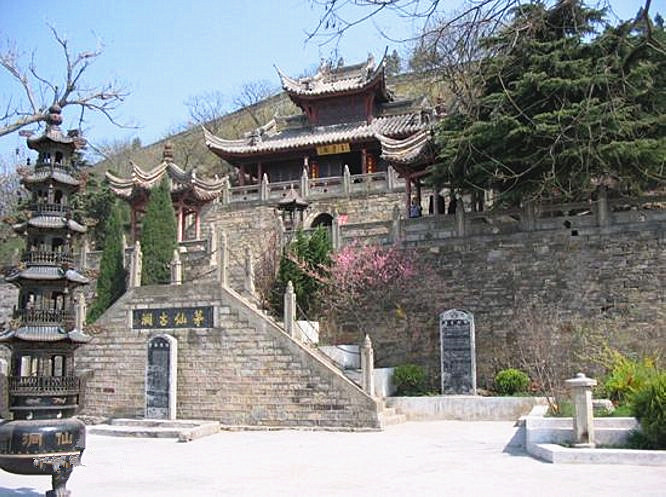
Xilongtan Pool and Sanjiao Palace in Kaiyuan City, Honghe
Overview of Sanjiao Palace
The Sanjiao Palace (三教殿) is located at the foot of Xilongtan (西龙潭) in the western part of Kaiyuan City, Yunnan Province. It is named after the three deities enshrined within: Guanyin (观音), Zhenwu (真武祖师), and Wenchang Dijun (文昌帝君). The building covers an area of 116 square meters.
Historical Background
Originally built during the Ming Dynasty (明代), the palace was initially known as Guanyin Temple (观音寺). It was destroyed during the turmoil of the Xianfeng Era (咸丰) in 1856. Reconstruction began with donations from officials and the public between 1898 and 1928. The architecture follows the slope of Longtan and is aligned along the central axis from west to east. The entire complex includes the main hall, middle hall, lower hall, two wings, and two symmetrical hexagonal pavilions, covering an area of 1900 square meters.
Architectural Features
The main hall features a single-eave hard hill roof with a wooden beam structure, measuring 13.5 meters long, 8 meters wide, and 9.6 meters high. The ceiling is adorned with elegant watercolor paintings of fruits, bamboo, and orchids. The side rooms, built in a two-story wooden structure, measure 10.7 meters long and 6.7 meters wide, standing at 8.5 meters high. Historically, the north wing housed statues of Mu Guiying (穆桂英) and other deities, symbolizing protection against autumn frosts.
The middle hall originally housed statues of Guanyin, Manjushri (文殊), and Samantabhadra (普贤), but these were destroyed in 1931. It was later renamed Caishen Hall (财神殿) after new statues of Earth Mother and the God of Wealth were added. The hexagonal pavilion, constructed in traditional wooden style, stands approximately 9 meters tall.
Recent Renovations
In 1994, community funding led to significant renovations, replacing decayed wooden columns with brick columns. By 1997, further improvements included the roof’s redesign and the replacement of grey tiles with yellow glazed tiles. In April 2004, additional decorative work was done, altering some historical aspects of the building.
Xilongtan Pool
Xilongtan (西龙潭), also known as West Dragon Pool, is located at the foot of Longtan Hill (龙潭坡), measuring over 20 meters in length and 10 meters in width, with a total area exceeding 200 square meters. Surrounded by stone walls, the back wall stands 5 meters high and is inscribed with the phrase “水不在深” (The depth of water is not what matters) by Wu Xizhong (吴锡忠), a renowned calligrapher from Yunnan during the late Qing Dynasty.
Natural Beauty and Cultural Significance
The springs flow from both sides of the pool, providing clear, sweet water year-round, with fish swimming and ancient trees leaning nearby. The water is considered a blessing, and locals often use it for making tea. Historically, this spring irrigated large fields outside the city, demonstrating its importance as an ancient irrigation facility.
Historical Poets and Cultural Reflections
During the Ming Dynasty, local poets like Wang Tingbiao (王庭表) wrote poems celebrating the beauty of the area, capturing the essence of their experiences and the enchanting landscape. For example, in his poem “游观音诗·答杨用修留别,” he expressed:
“太平风物在南州,鹤舞春郊与客游。 气象欲干千缕笔,逍遥还听白云讴。”
Current Usage
Today, the Sanjiao Palace continues to serve as a multi-deity temple. It houses numerous statues of various deities including the Dragon King, God of Wealth, Earth Mother, and others, reflecting the rich cultural tapestry of Chinese religious practices.
How to Get There
To reach Xilongtan Pool and Sanjiao Palace in Kaiyuan City, you can take a bus or drive from nearby cities like Kunming (昆明). The journey typically takes about 2-3 hours by car, depending on traffic conditions. Local buses frequently operate from the city center.
Travel Tips
- Best Time to Visit: The ideal time to visit Honghe Hani and Yi Autonomous Prefecture is during the months of March-April and September-November when the weather is mild and rainfall is minimal.
- Cultural Etiquette: When visiting temples, dress modestly and show respect during prayers. Photography may be restricted in certain areas, so always ask for permission.
- Local Cuisine: Don’t miss trying local dishes, especially those made with fresh ingredients from the area. Enjoy tea brewed with the pure spring water for a unique experience.
- Weather Considerations: The region experiences a subtropical plateau monsoon climate, so be prepared for varying weather conditions, particularly in the rainy season from May to October.


 7 Days GolfingTour
7 Days GolfingTour
 8 Days Group Tour
8 Days Group Tour
 8 Days Yunnan Tour
8 Days Yunnan Tour
 7 Days Shangri La Hiking
7 Days Shangri La Hiking
 11 Days Yunnan Tour
11 Days Yunnan Tour
 6 Days Yuanyang Terraces
6 Days Yuanyang Terraces
 11 Days Yunnan Tour
11 Days Yunnan Tour
 8 Days South Yunnan
8 Days South Yunnan
 7 Days Tea Tour
7 Days Tea Tour
 8 Days Muslim Tour
8 Days Muslim Tour
 12 Days Self-Driving
12 Days Self-Driving
 4 Days Haba Climbing
4 Days Haba Climbing
 Tiger Leaping Gorge
Tiger Leaping Gorge
 Stone Forest
Stone Forest
 Yunnan-Tibet
Yunnan-Tibet
 Hani Rice Terraces
Hani Rice Terraces
 Kunming
Kunming
 Lijiang
Lijiang
 Shangri-la
Shangri-la
 Dali
Dali
 XishuangBanna
XishuangBanna
 Honghe
Honghe
 Kunming
Kunming
 Lijiang
Lijiang
 Shangri-la
Shangri-la
 Yuanyang Rice Terraces
Yuanyang Rice Terraces
 Nujiang
Nujiang
 XishuangBanna
XishuangBanna
 Spring City Golf
Spring City Golf
 Snow Mountain Golf
Snow Mountain Golf
 Stone Mountain Golf
Stone Mountain Golf



















